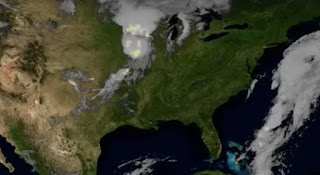The GOES-17 is from the new generation of geostationary weather satellites, with advanced sensors and roughly twice the horizontal resolution. They provide color visible imagery, more frequent scans, and even the ability to observe lightning from space. The first of the generation (GOES-16) is in place over the eastern U.S. and GOES-17 was meant to replace the western NOAA/NWS geostationary satellite (GOES-15) that was launched on 2010.
The most important new system on the satellite is the Advanced Baseline Imager (ABI) that provides high resolution visible and infrared radiation information.
Here is one of first images from GOES-17 ABI. Full color, high resolution. The satellite is over the equator and sees the whole hemisphere. And it will be moved westward later to its final position at 137W longitude.
Here is an animation fro GOES-16 of low-level clouds along the California coast...just marvelous.
And here is image showing example of lightning observed by GOES-17.
How about a video of some smoke from wildfires over Canada observed by the new satellite?
GOES-17 was scheduled to go operational later this year, replacing GOES-15.
But there is a problem.... a serious one.
The infrared sensors on GOES-17 must be cooled to around 60 Degrees Kelvin (minus 351 degrees Fahrenheit) to enable them to be fully sensitive to infrared light coming up from below. The problem is that for roughly 12 hours each day, the cooler inside the Advanced Baseline Imager is unable to chill the detectors to such cold temperatures. Bad AC.
And there is no way to send a technician up to the orbit of the satellite (about 35,000 km above the surface). Perhaps there is some remote fix possible, but if not, we will have a substantially degraded weather satellite in orbit.
Visible imagery will be fine, lightning information will be available, but critical infrared imagery (and vertical soundings) will be degraded for half the day. In the meantime, the old weather satellite (GOES-15) is working fine for the time being.
 |
| The GOES ABI |
from Cliff Mass Weather and Climate Blog https://ift.tt/2HhVIxr



No comments:
Post a Comment